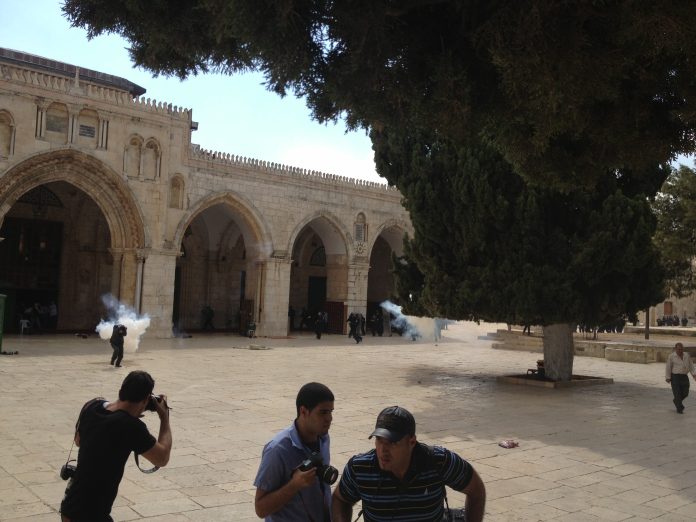Amnon Cohen, Committee for a Workers’ International
The brutal police attack on Palestinians in the al-Aqsa mosque on 5 April has unleashed a new wave of conflict. Footage shows paramilitary police using long batons to relentlessly beat Palestinian men and women inside the third holiest site in Islam during Ramadan, causing outrage.
In a huge understatement, the Arab League group of nations said that this put “regional stability at risk”. 44 missiles were fired from Gaza into southern Israel, and 34 were fired from Lebanon into northern Israel – the largest barrage there since 2006. The Israeli state immediately fired missiles into Gaza and Lebanon. Demonstrators clashed with police in East Jerusalem, as well as in Arab towns in Israel, including Nazareth, Sakhnin, Baqa al-Gharbiyye and Kafr Manda.
In separate attacks, a tourist was killed in a Tel Aviv car raid, and three were shot dead in an Israeli settlement in the West Bank. The number of Palestinians killed this year has risen to over 100. By comparison, 231 were killed in the whole of last year, that itself the deadliest since 2005.
The Israeli police actions were intended to clear the al-Aqsa mosque (Haram al-Sharif) – known to Jews as Temple Mount – of Palestinians ahead of a visit of members of the messianic Temple Mount Movement the following morning. The Temple Mount Movement wants to rebuild the Jewish Temple (destroyed by the Romans in 70AD) on the site of the Dome of the Rock and the Al Aqsa mosque, built in the 7th and 8th Centuries. They believe that the consecration of the Third Temple would bring about the coming of the messiah.
In the 1980s, members of the Jewish Underground, a right-wing vigilante group, were arrested for planning to blow up the Dome of the Rock. A number of its supporters were arrested on 6 April trying to bring animals onto the Haram al-Sharif in order to slaughter them for ritual sacrifice.
The majority popular opinion in Israel is to reject the Temple Mount Movement as dangerous zealots. But they are supported by the ultra-nationalist faction which the Netanyahu government depends on for the survival of its majority, including national security minister Itamar Ben-Gvir.
Residents of northern and southern Israel living under Hamas missile attacks have been told to stay near air-raid shelters. But successive governments have shown their contempt for these poverty stricken working-class communities by cutting schemes to retrofit homes with shelters.
Around 50,000 Israelis living within nine kilometres of the Lebanon border still do not have usable shelters. Both the north and the south of Israel – considered by the state as the ‘periphery’ – are unemployment black spots, whose population consists of the most downtrodden sections of the working class, including in the north Israeli Palestinians. The rockets fired into these areas have, so far, not caused any casualties. Marxists totally oppose such indiscriminate attacks on working-class communities, and acts of individual terror such as the Tel Aviv car raid and West Bank shootings. They can only help to rally support around the beleaguered Netanyahu government.
This dramatic escalation of the conflict occurs after 13 weeks of mass protests have brought hundreds of thousands of Israelis out onto the streets against the government’s assaults on ‘democracy’.
Many of the self-appointed capitalist leaders of the protest movement have fallen behind the ultra-right government as military conflict has developed. Prominent capitalist opposition politician Benny Gantz says the opposition will give its full support to the government in responding to the escalating violence, and calls on people to unite behind it. Opposition leader Yair Lapid said: “When it comes to security, there is no opposition and there is no coalition”.
Ultimately the capitalist ruling class has no solution to the national conflict, and no alternative to the brutal repression of the Palestinians. The Netanyahu government cannot be defeated by Hamas missiles fired into working-class communities, which could only be used to bolster his support. His supporters and the far-right will try to use this situation to consolidate their shrinking support.
The general strike of 27 March showed the power of the working class to force Netanyahu into retreat. The mass protests, which have brought hundreds of thousands onto the streets, need to shake off the capitalist leaders, such as Gantz and Lapid.
Protest organisers called for the continuation of protests: “Citizens to go out to the streets in masses on Saturday [8 April]”. Tens of thousands responded to the call. This should be welcomed. But there should also be a call for further escalation of strike action along with mass mobilisations.
Crucially, activists and organisations involved in the movement should form an independent mass workers’ party, take control of their own movement and wage a decisive challenge to the government.
The movement needs to link up with Palestinians protesting and confronting the repressive forces of the state, in the Palestinian towns in Israel, as well as in the territories. The working class, united, has the power to defeat the ultra-nationalist government of Netanyahu and Ben Gvir, and pull the Middle East back from the carnage of regional conflict.







